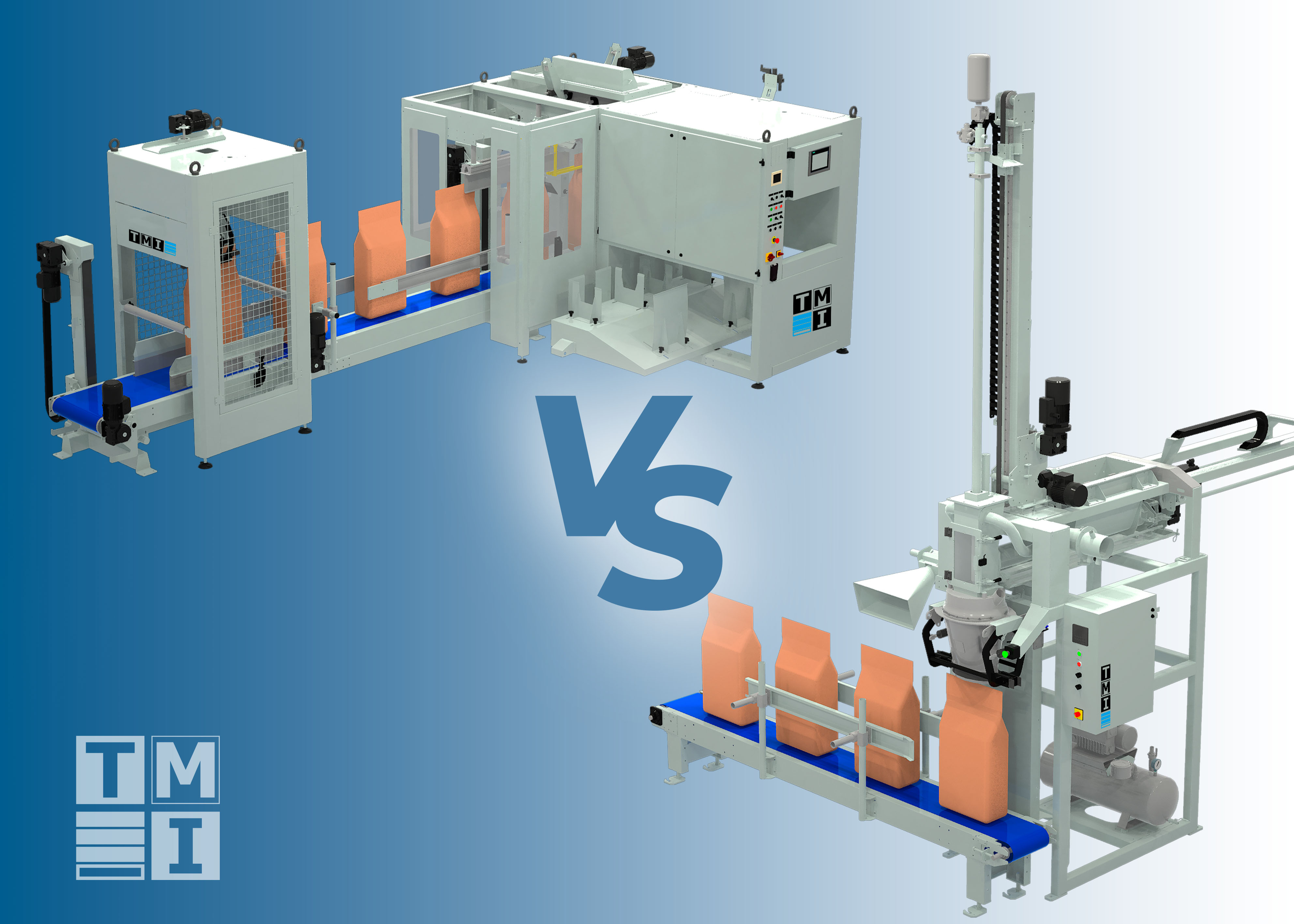
-
Company
-
We talk your language
TMI is your partner for bagging, palletizing and stretch-wapping systems.
- About us
- Talented people
- News
-
-
Solutions
-
Complete bagging lines
TMI manufactures complete bagging lines: from the dosing of the finished product to the protection of the load. We supply bagging machines, palletizers and stretch-wrapping systems that suit your needs. Browse through our portfolio and find the optimal solution for your end of line.
- Bagging systems
- Bag palletizing systems
- Pallet stretch-wrapping
- Industry 4.0
-
-
Industries
-
Solutions that fit your project
We develop bagging and palletizing solutions for different industries. Choose yours to see the solutions that best suit your needs.
- Food
- Agri-food
- Chemicals & petrochemicals
- Construction & mining
- Recycling
-
- Services
- Contact
- Ask for a quotation
-
Company
-
We talk your language
TMI is your partner for bagging, palletizing and stretch-wapping systems.
-
-
Solutions
-
Complete bagging lines
TMI manufactures complete bagging lines: from the dosing of the finished product to the protection of the load. We supply bagging machines, palletizers and stretch-wrapping systems that suit your needs. Browse through our portfolio and find the optimal solution for your end of line.
-
-
Industries
-
Solutions that fit your project
We develop bagging and palletizing solutions for different industries. Choose yours to see the solutions that best suit your needs.
-
- Services
- Contact
We talk your language
News
AUTOMATIC BAGGING MACHINE OR SEMI-AUTOMATIC BAGGING MACHINE: WHICH IS RIGHT FOR YOUR PROJECT?
March 02, 2022
Are you looking to install an end-of-line bagging machine but unsure of the level of automation you require? This article will help you to understand which type of bagging machine suits your needs the best.

‘Are you looking for an automatic or a semi-automatic solution?’ asks a TMI sales adviser, near the start of a telephone call with a new client.
The voice on the other end of the phone hesitates:
‘Well… We’re not sure. Could you tell me more about each type’s characteristics?’
‘No problem’, and the adviser goes on to explain the key differences between the two and their features.
This conversation happens a lot at TMI. And that’s completely natural, because our clients tend not to be bagging experts. But we are, so we can help them every step of the way to design their end-of-line project.
To do so, various factors must be taken into account. Let’s take a look at the main characteristics of these two types of bagging machine and some key tips for identifying which kind of solution you need for your project:
SEMI-AUTOMATIC BAGGING MACHINE
What is a semi-automatic bagging machine?
A semi-automatic bagging machine is a system for packaging products in bags. Its main function is to precisely weigh out, dose and insert a solid product into the bag, based on a previously established recipe. It may be equipped with a net weight or a gross weight weighing system, depending on the type of production. However, as its name indicates, a semi-automatic bagging machine cannot function on its own; it needs a human to operate it. An operator must place the bag at the filling point, press a button to start the filling cycle, and remove the bag once it is full.
The main benefits of semi-automatic bagging machines are as follows:
- Easy maintenance
- Swift cleaning process
- Quick return on investment, thanks to its low cost
- Easy operation: no need for prior training
- Quick, simple installation
- Flexible, quick format changes
But they also have their disadvantages:
- Production limited by operator efficiency
- Need for an operator to be available for bagging
- Significant physical effort required from the operator
In what cases is installing a semi-automatic bagging machine advisable?
Both net weight and gross weight semi-automatic bagging machines can be used in all industries for a huge variety of products. But, broadly, they are more suitable for projects with one or more of the following characteristics:
- The required bags-per-hour production speed is low
- The planned budget for the investment is low
- Small batches are being produced or the product is changed frequently, especially if strict hygiene measures must be followed between products, or the product manufacturing speed is low
- There are operators available in the area and labour costs are low
- There is little space available for bagging
Are all semi-automatic bagging machines the same?
Not at all. The type of product to be bagged and the type of bag used are also important to consider when designing the solution that meets your end-of-line needs.
TMI offers a wide range of semi-automatic bagging machines, including the models ILERFIL AB, ILERFIL ABS, ILERFIL AN, ILERFIL VBG and ILERFIL VBF.
AUTOMATIC BAGGING MACHINE
What is an automatic bagging machine?
An automatic bagging machine is a packaging system with the same ultimate goal as a semi-automatic bagging machine: to weigh out precise quantities of a solid product and insert them into bags. The main difference is that an automatic bagging machine does this without human intervention. In other words, the machine itself takes the bag, opens it, places it at the bagging point, fills it, removes it from the bagging point, closes it and ejects it.
Of course, the technology used to carry out all of these processes automatically is more complex than the technology used in manual bagging.
The main benefits of automatic bagging machines are:
- Total automation of the bagging process
- Optimized production at the bagging point
- A single operator can take care of supervision and supply of consumables
- A safer, cleaner workplace
- Control over the bag position at all times while it is being handled
But this kind of machine also has some disadvantages:
- The initial investment required is usually higher than that needed for a semi-automatic bagging machine
- They usually take up more floor space than semi-automatic bagging machines (though there are some very compact versions available)
- Installation must be carried out by a qualified technician sent by the manufacturer
In what cases is installing an automatic bagging machine advisable?
TMI has automatic bagging machines for all industries and all products. We have made automatic bagging machines for animal feed, additives, chemicals, granules, pellets, minerals, and much more. However, of course, an automatic bagging machine is not always necessary. These are some of the key cases in which an end-of-line project will require an automatic bagging machine:
- The required bags-per-hour production speed is medium to high
- The product requires you to guarantee a ROI through sustained production and productivity
- There are few operators available in the area or labour costs are high in the country
Types of automatic bagging machines
Automatic bagging machines can be divided into four main groups: automatic bagging machines for open-mouth bags, automatic bagging machines for SOS bags, automatic bagging machines for valve bags and automatic FFS bagging machines.
Thanks to this technological diversity, automatic bagging machines can handle different types of bags and materials: flat bags or bags with gussets, made from paper, polyethylene or woven PP (WPP); SOS bags; valve bags; FFS (form-fill-seal) bags, and more. So, automatic bagging machines can handle more types of bags than semi-automatic bagging machines.
HOW DO I CHOOSE BETWEEN ALL OF THESE OPTIONS?
You have probably noticed by now that this issue is a bit more complex than it might seem at first. We have therefore put together a series of questions you should ask yourself in order to find the right solution:
- What level of production are you aiming for?
- What type (or types) of bag will be used?
- Will there be more than one bagging format?
- How much space is available?
- What ROI do you require for the project to be viable?
- Is there plenty of labour available near the plant? Or is it scarce?
Now you know the difference between automatic and semi-automatic bagging machines and the importance of specifying the level of automation you need when embarking on an end-of-line project. Would you like some advice at this stage in the process? Contact us now for a no-obligation consultation.
Next article
April 13, 2022
May 2022 will be a month of get-togethers and face-to-face networking, because TMI will be on tour: EXPOSOLIDOS, HISPACK and DJAZAGRO are the three must-attend events you can't miss.

TMI Técnicas Mecánicas Ilerdenses SL in the framework of the ICEX Next Program, has been supported by ICEX and co-financed by the European ERDF fund. The purpose of this support is to contribute to the international development of the company and its environment.

Company
Address
Polígono Industrial Camí dels Frares,
C/ Alcarràs, parc 66 - 25190 - Lleida · SPAIN Tel. +34 973 25 70 98



